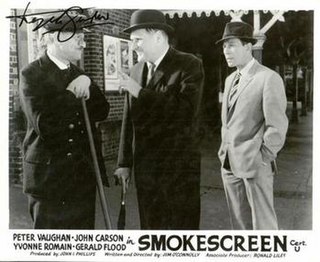
Open All Night is a 1934 British drama film directed by George Pearson and starring Frank Vosper, Margaret Vines, Gillian Lind, Geraldine Fitzgerald and Michael Shepley. It was made at Twickenham Studios in London. The film's sets were designed by the art director James Carter. The film was produced as a quota quickie by Julius Hagen for distribution by RKO Pictures. It was later released in the United States under the alternative title Murder by Appointment.

The Broken Horseshoe is a 1953 British "B" crime film directed by Martyn C. Webster and starring Robert Beatty, Elizabeth Sellars, Peter Coke, and Hugh Kelly. It was written by A. R. Rawlinson based on the BBC television series of the same title from the previous year. A surgeon is drawn into a murder case.

Smokescreen is a 1964 British comedy crime drama film, written and directed by Jim O'Connolly and starring Peter Vaughan.

Mantrap, released in the United States as Man in Hiding, is a 1953 British second feature whodunit directed by Terence Fisher, starring Paul Henreid and Lois Maxwell. It was written by Fisher and Paul Tabori based on the 1952 novel Queen in Danger by Trevor Dudley-Smith.

The Painted Smile is a 1962 British second feature thriller film directed by Lance Comfort and starring Liz Fraser, Kenneth Griffith, Peter Reynolds and Tony Wickert. It was written by Pip and Jane Baker.

Blind Man's Bluff is a 1952 British 'B' crime film directed by Charles Saunders and starring Zena Marshall, Sydney Tafler, and Anthony Pendrell. It was written by John Gilling.

The Hypnotist is a 1957 British thriller film directed and written by Montgomery Tully and starring Paul Carpenter, Patricia Roc and Roland Culver. It is based on a 1956 play by Falkland Cary. A hypnotist has grown sick of his wife and attempts to convince one of his patients to murder her.

Trouble with Eve is a 1960 British second feature comedy film directed by Francis Searle and starring Hy Hazell, Sally Smith, Robert Urquhart and Garry Marsh. The screenplay was by Brock Williams based on the 1953 play Widows are Dangerous by June Garland. It was shot at Walton Studios. The film was released in the U.S. in 1964 as In Trouble With Eve.
Fingers is a 1941 British drama film directed by Herbert Mason, produced by A.M.Salomon for Warner Bros and starring Clifford Evans, Leonora Corbett and Esmond Knight. Its plot involves a London jeweller and fence for stolen goods who falls in love and tries to reform.

Recoil is a 1953 British 'B' crime film directed by John Gilling and starring Kieron Moore, Elizabeth Sellars and Edward Underdown.

Radio Cab Murder is a 1954 British second feature crime film directed by Vernon Sewell and starring Jimmy Hanley, Lana Morris and Sonia Holm. It was made by the independent Eros Films.

Compelled is a 1960 British second feature ('B') neo noir black and white crime film directed by Ramsey Herrington and starring Ronald Howard and Beth Rogan. It was written by Mark Grantham and produced by the Danziger Brothers.

Strip Tease Murder is a low budget 1961 British second feature film thriller directed by Ernest Morris and starring John Hewer and Ann Lynn. It was written by Paul Tabori and produced by The Danzigers.

Escort for Hire is a low budget 'B' 1960 British thriller film directed by Godfrey Grayson and starring June Thorburn, Pete Murray, Noel Trevarthen, Jan Holden and Peter Butterworth. It was written by Mark Grantham and produced by the Danzigers.

Men Against the Sun is a 1952 British historical adventure film directed by Brendan J. Stafford and starring John Bentley and Zena Marshall. It depicts the attempts to construct a railway in late Victorian Africa. It was shot on location in Kenya. This was unusually ambitious for a second feature film at the time.

The Key Man is a 1957 British black and white second feature directed by Montgomery Tully and starring Lee Patterson, Paula Byrne and Colin Gordon. The screenplay was by Julian MacLaren-Ross adapted from his original story. The film was released in the USA by United Artists.
The Late Edwina Black is a 1964 Australian television play, filmed in Sydney. It was based on a play by William Morum and William Dinner which had been filmed numerous times before. It was adapted by Noel Robinson. The play was first broadcast on 23 September 1964 in Melbourne, 16 September 1964 in Sydney, and on 7 October 1964 in Brisbane.

Night of the Prowler is a 1962 British crime 'B' film directed by Francis Searle and starring Patrick Holt, Colette Wilde and John Horsley. It was written by Paul Erickson.

Profile is a 1954 British second feature ('B') thriller film directed by Francis Searle and starring John Bentley, Kathleen Byron and Thea Gregory. It was written by John Temple-Smith, Maurice Temple-Smith and John Gilling.

Attempt to Kill is a 1961 British second feature ('B') film directed by Royston Morley and starring Derek Farr and Tony Wright. The screenplay was by Richard Harris, based on the 1929 Edgar Wallace novel The Lone House Mystery. It is part of the series of Edgar Wallace Mysteries films made at Merton Park Studios from 1960 to 1965.


















